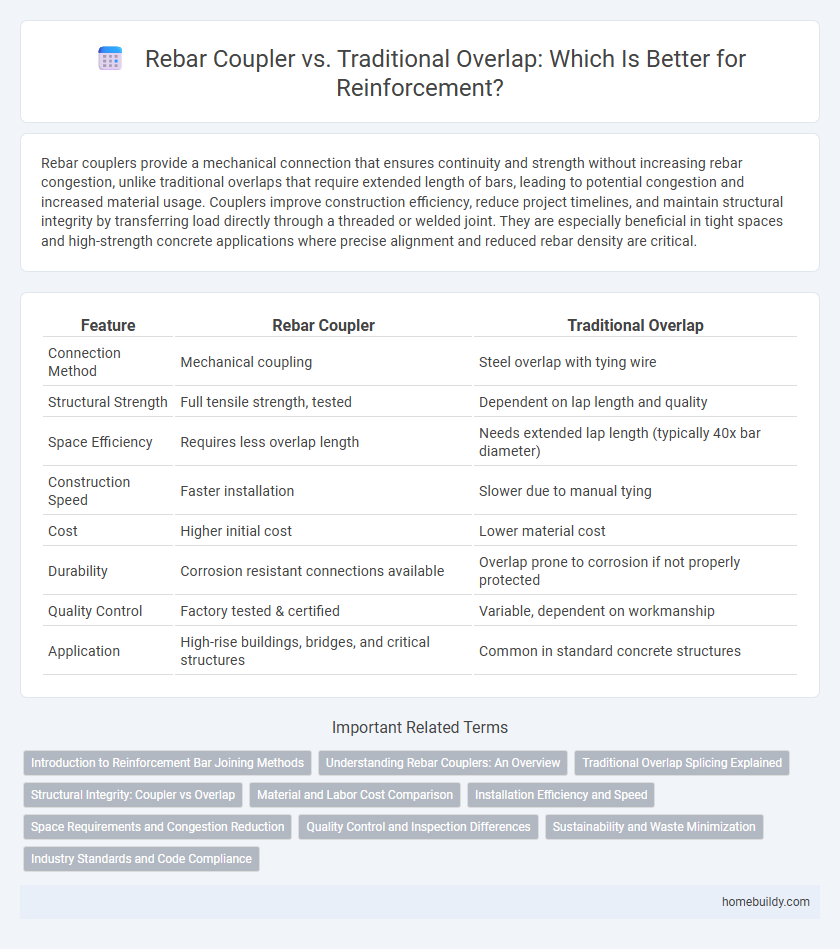Rebar couplers provide a mechanical connection that ensures continuity and strength without increasing rebar congestion, unlike traditional overlaps that require extended length of bars, leading to potential congestion and increased material usage. Couplers improve construction efficiency, reduce project timelines, and maintain structural integrity by transferring load directly through a threaded or welded joint. They are especially beneficial in tight spaces and high-strength concrete applications where precise alignment and reduced rebar density are critical.
Table of Comparison
| Feature | Rebar Coupler | Traditional Overlap |
|---|---|---|
| Connection Method | Mechanical coupling | Steel overlap with tying wire |
| Structural Strength | Full tensile strength, tested | Dependent on lap length and quality |
| Space Efficiency | Requires less overlap length | Needs extended lap length (typically 40x bar diameter) |
| Construction Speed | Faster installation | Slower due to manual tying |
| Cost | Higher initial cost | Lower material cost |
| Durability | Corrosion resistant connections available | Overlap prone to corrosion if not properly protected |
| Quality Control | Factory tested & certified | Variable, dependent on workmanship |
| Application | High-rise buildings, bridges, and critical structures | Common in standard concrete structures |
Introduction to Reinforcement Bar Joining Methods
Rebar couplers provide a mechanical connection for reinforcement bars, offering a reliable alternative to traditional overlapping methods that require extended bar lengths and increased concrete cover. This technique enhances structural integrity by minimizing stress concentration and enabling faster, more efficient construction with reduced material waste. Compared to traditional lap splicing, couplers improve load transfer, especially in seismic zones, ensuring stronger and more durable reinforced concrete structures.
Understanding Rebar Couplers: An Overview
Rebar couplers provide a mechanical connection that transfers load between reinforcement bars, offering a reliable alternative to traditional overlap splicing methods. They improve structural integrity by reducing congestion and material usage, enhancing construction efficiency in seismic and high-load applications. Compared to traditional overlap splices, rebar couplers minimize bar length requirements and ensure precise alignment for superior joint performance.
Traditional Overlap Splicing Explained
Traditional overlap splicing involves placing two reinforcement bars end-to-end with an overlapping length to transfer tensile forces through friction and bond with the surrounding concrete. The required overlap length depends on factors such as bar diameter, concrete strength, and rebar grade, ensuring structural integrity and load transfer. This method is widely used due to its simplicity but can lead to congestion and material waste compared to mechanical splicing alternatives like rebar couplers.
Structural Integrity: Coupler vs Overlap
Rebar couplers provide enhanced structural integrity by creating a direct mechanical connection between bars, eliminating the weaknesses associated with traditional lap splices that rely on overlapping and concrete adhesion. Unlike overlap splicing, couplers maintain consistent bar alignment and reduce congestion, which minimizes stress concentrations and improves load transfer efficiency in reinforced concrete structures. Engineering studies show that coupler joints achieve higher tensile strength and ductility, making them more reliable for critical infrastructural applications compared to traditional overlapping methods.
Material and Labor Cost Comparison
Rebar couplers reduce material waste by minimizing the length of overlapping bars required, thereby optimizing steel usage compared to traditional lap splicing. Labor costs decrease significantly with couplers due to faster installation times and simplified alignment, cutting overall project expenses. Although couplers may have higher initial unit costs, the combined savings in material and labor result in a more cost-effective solution over the project lifecycle.
Installation Efficiency and Speed
Rebar couplers significantly improve installation efficiency by providing a mechanical splice that eliminates the need for long overlapping lengths, reducing material waste and labor time on-site. Unlike traditional overlap splicing, couplers enable faster alignment and secure connections, accelerating project timelines and lowering labor costs. This streamlined process supports improved quality control and minimizes congestion in congested reinforcement areas, enhancing overall construction productivity.
Space Requirements and Congestion Reduction
Rebar couplers significantly reduce space requirements by eliminating the need for extended overlapping lengths, allowing for more efficient use of structural areas and reducing congestion in critical zones. Traditional overlap splicing requires longer bars to overlap, leading to increased rebar density that complicates concrete placement and can weaken structural integrity due to improper compaction. Utilizing couplers streamlines reinforcement layouts, enhancing both constructability and performance in densely reinforced sections.
Quality Control and Inspection Differences
Rebar couplers provide a more consistent and reliable connection compared to traditional overlaps, significantly improving quality control by eliminating issues like inadequate lap length and corrosion at splice zones. Inspection processes for couplers are more straightforward, relying primarily on visual checks and torque verification, whereas traditional overlaps require extensive measurement and inspection to ensure correct lap length and alignment. This streamlined inspection reduces chances of human error, ensuring higher structural integrity in reinforced concrete applications.
Sustainability and Waste Minimization
Rebar couplers significantly reduce material waste compared to traditional overlap splicing by eliminating the need for excess rebar length, enhancing sustainability in construction projects. The use of mechanical couplers minimizes scrap generation and optimizes resource utilization, contributing to lower environmental impact. This method promotes efficient steel use and supports green building practices by reducing CO2 emissions associated with rebar production and transportation.
Industry Standards and Code Compliance
Rebar couplers provide a compliant alternative to traditional overlap splicing by meeting stringent industry standards such as ACI 318 and BS EN 1992-1-1, ensuring structural integrity and uniform stress transfer. Unlike conventional lap splices that require extended lengths to maintain code compliance, couplers reduce congestion and labor while adhering to seismic and load-bearing requirements set forth by international building codes. Their use promotes enhanced quality control and inspection efficiency, aligning with modern construction regulations and sustainability goals.
Rebar coupler vs Traditional overlap Infographic

 homebuildy.com
homebuildy.com